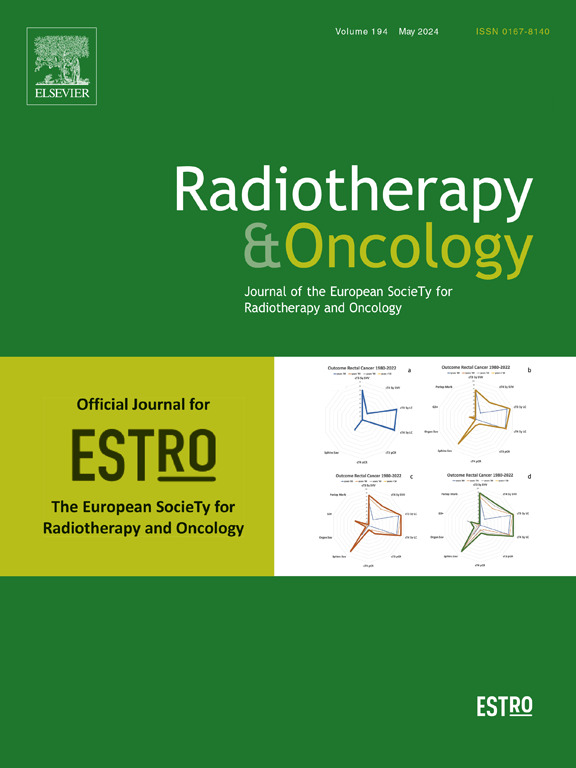使用短疗程放疗和FOLFOXIRI治疗直肠癌的器官保存计划II期试验(SHORT-FOX):两年主要结局分析
IF 4.9
1区 医学
Q1 ONCOLOGY
引用次数: 0
摘要
背景与目的新辅助治疗后临床完全缓解(cCR)的直肠癌患者可以安全地避免全肠系膜切除术(TME),但需要最大化cCR的策略。材料和方法我们进行了一项单臂II期研究,以确定剂量递增的短期放疗(25 Gy/5次+ 5 Gy/1次强化)后8个周期FOLFOXIRI是否会增加成年患者的cCR率。T2N0M0或低T2N0直肠癌。结果在2020年至2023年期间,我们纳入了37例患者,其中27例(73%)具有至少一项高危特征(cT4、外血管侵犯[EMVI]、N2、威胁周切缘、外侧淋巴结阳性)。在主要终点评估中,9名(24%)患者在内窥镜检查和MRI检查中均出现cCR,并寻求器官保存(OP)。14例(38%)患者仅在内镜检查时出现cCR,其中9例接受手术治疗。在18例接受手术治疗的患者中,9例在放疗开始2年后出现局部再生,2年无tme生存率为26%。未实现OP显著相关的基线因素包括年龄和年龄;50岁和T4疾病。在治疗中期再分期时,达到OP的患者出现持续性淋巴结阳性、EMVI和内镜下可见肿瘤的可能性显著降低。至少可能归因于化疗和放疗的3+级不良事件分别发生在51%和43%的患者中。结论:1 / 4的高危直肠癌患者短期放疗加强化后FOLFIXIRI可导致OP,年轻患者和T4疾病患者疗效较差。治疗中期反应可能有助于指导有关治疗的及时决策。本文章由计算机程序翻译,如有差异,请以英文原文为准。
Phase II trial of organ preservation program using short-course radiation and FOLFOXIRI for rectal cancer (SHORT-FOX): Two-Year primary outcome analysis
Background and purpose
As patients with rectal cancer with clinical complete response (cCR) after neoadjuvant therapy may be safely spared Total Mesorectal Excision (TME), strategies to maximize cCR are needed.
Materials and Methods
We conducted a single-arm phase II study to determine whether dose-escalated short-course radiotherapy (25 Gy/5 fractions + 5 Gy/1 fraction boost) followed by eight cycles of FOLFOXIRI increased cCR rates among adult patients with > T2N0M0 or low T2N0 rectal cancer.
Results
Between 2020 and 2023, we enrolled 37 patients, of whom 27 (73 %) had at least one high-risk feature (cT4, extramural vascular invasion [EMVI], N2, threatened circumferential resection margin, positive lateral node). At primary endpoint assessment, nine (24 %) patients had cCR on both endoscopy and MRI, and pursued organ preservation (OP). Fourteen (38 %) patients had cCR only on endoscopy, nine of whom pursued OP. Of the 18 patients who pursued OP, nine had local regrowth at two years from radiotherapy start, with two-year TME-free survival of 26 %. Baseline factors significantly associated with not achieving OP included age < 50 years and T4 disease. At mid-treatment restaging, patients who achieved OP were significantly less likely to have persistent node positivity, EMVI, and endoscopically visible tumor. Grade 3+ adverse events at least possibly attributed to chemotherapy and radiotherapy occured in 51% and 43% of patients, respectively.
Conclusion
Short-course radiotherapy with a boost followed by FOLFIXIRI results in OP in one-quarter of patients with high-risk rectal cancer, with poorer response among younger patients and T4 disease. Mid-treatment response may help guide timely decision-making regarding treatment.
求助全文
通过发布文献求助,成功后即可免费获取论文全文。
去求助
来源期刊

Radiotherapy and Oncology
医学-核医学
CiteScore
10.30
自引率
10.50%
发文量
2445
审稿时长
45 days
期刊介绍:
Radiotherapy and Oncology publishes papers describing original research as well as review articles. It covers areas of interest relating to radiation oncology. This includes: clinical radiotherapy, combined modality treatment, translational studies, epidemiological outcomes, imaging, dosimetry, and radiation therapy planning, experimental work in radiobiology, chemobiology, hyperthermia and tumour biology, as well as data science in radiation oncology and physics aspects relevant to oncology.Papers on more general aspects of interest to the radiation oncologist including chemotherapy, surgery and immunology are also published.
 求助内容:
求助内容: 应助结果提醒方式:
应助结果提醒方式:


